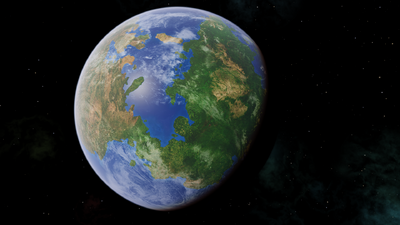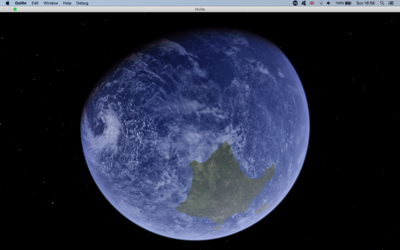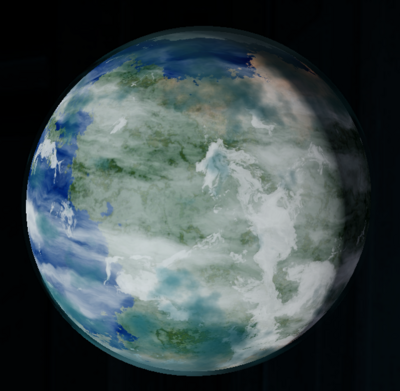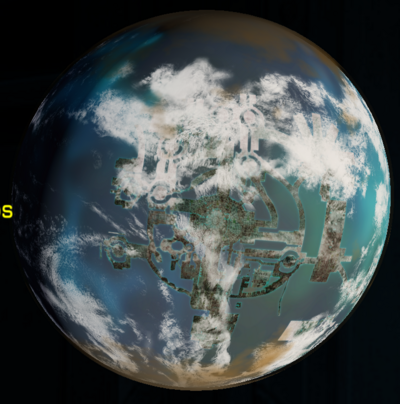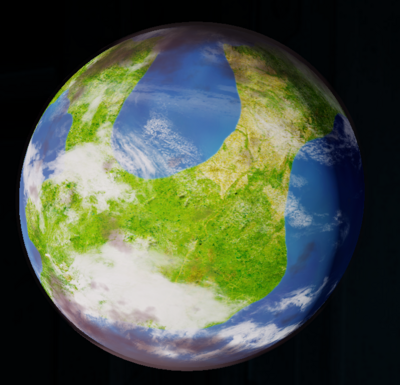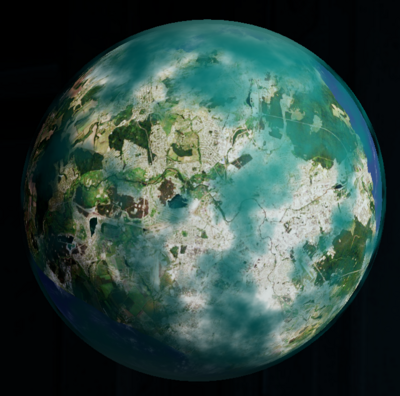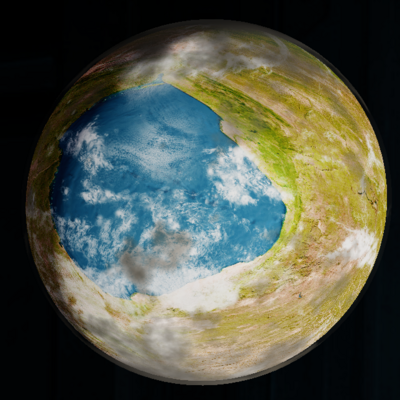Difference between revisions of "Famous Planets Overhaul (FPO)"
Cholmondely (talk | contribs) (Tweaks!) |
m (→Links) |
||
| (6 intermediate revisions by one other user not shown) | |||
| Line 10: | Line 10: | ||
== Overview == | == Overview == | ||
| − | 102 planet highly detailed planet textures for the main planets in | + | 102 planet highly detailed planet textures for some of the main planets in Galaxies 1 & 2. The other 410 planets are not yet included. |
| − | This is a suite of | + | This is a suite of 5 oxp's - one overarching oxp (which includes the planet descriptions for the F7 screen), a music pack for 10 of the planets and another three filled with the textures. |
They were last updated in 2016, and so precede the most recent improvements in planet rendering. They still look superb! | They were last updated in 2016, and so precede the most recent improvements in planet rendering. They still look superb! | ||
| Line 21: | Line 21: | ||
At this time [[User:Submersible|Submersible]] was creating new planet textures, and these ended up including PAGroove's Famous Planets textures too. They were eventually published as [[Povray Planets]] - highly detailed planet textures for every main planet in each of the 8 galaxies. PAGroove removed the textures and the music (which he had other plans for) and expanded the F7 screen descriptions, creating the current in-game [[Expansions Manager]] version of Famous Planets in 2013. | At this time [[User:Submersible|Submersible]] was creating new planet textures, and these ended up including PAGroove's Famous Planets textures too. They were eventually published as [[Povray Planets]] - highly detailed planet textures for every main planet in each of the 8 galaxies. PAGroove removed the textures and the music (which he had other plans for) and expanded the F7 screen descriptions, creating the current in-game [[Expansions Manager]] version of Famous Planets in 2013. | ||
| − | Meanwhile, [[User:Stranger|Stranger]], who greatly prefers astronomical realism, took | + | Meanwhile, [[User:Stranger|Stranger]], who greatly prefers astronomical realism, took PAGroove's original concept, developing it further with even more highly detailed textures - and adding more planets. |
Then, with the recent improvements in Oolite's rendering of planets, he took two of them - Lave & Zaonce, and updated the textures to take advantage of the improvements. Hence his two oxp's on the in-game Expansions Manager ([[FPO Lave]] & [[FPO Zaonce]]). Zaonce has a new texture from that in his original FPO suite of oxp's. | Then, with the recent improvements in Oolite's rendering of planets, he took two of them - Lave & Zaonce, and updated the textures to take advantage of the improvements. Hence his two oxp's on the in-game Expansions Manager ([[FPO Lave]] & [[FPO Zaonce]]). Zaonce has a new texture from that in his original FPO suite of oxp's. | ||
| Line 34: | Line 34: | ||
A revolution is an interesting but an uncomfortable time. New solutions provide new opportunities, but do not co-exist easily with the old ones. Leaving everything as it is and gradually redoing everything piece by piece is reasonable, but not always possible. | A revolution is an interesting but an uncomfortable time. New solutions provide new opportunities, but do not co-exist easily with the old ones. Leaving everything as it is and gradually redoing everything piece by piece is reasonable, but not always possible. | ||
| − | Oolite v.1.90 introduced new impressive features. Now you can make worlds of marvelous beauty by hand assembling them with mirrored ponds, relief and atmospheric haze, and they are no longer not just balls which are pasted over with matte photo wallpapers. So why not slowly replace my obsolete System Makeup textures on this new basis? | + | Oolite v.1.90 introduced new impressive features. Now you can make worlds of marvelous beauty by hand-assembling them with mirrored ponds, relief and atmospheric haze, and they are no longer not just balls which are pasted over with matte photo wallpapers. So why not slowly replace my obsolete System Makeup textures on this new basis? |
But the fact is that the new textures consist of two layers - a diffuse map (the same photo wallpapers) and a normal map, in which there is just information about the relief and the mirror ponds. And alas, Oolite v.1.90 can read this normal map only if it is registered in the planetinfo.plist. Doing so through the javascript, alas, is not possible. That is, this wonderfully smart mechanism for choosing the appearance of the planet, taking into account the mice and frogs living on it, does not, alas, work with the new textures. | But the fact is that the new textures consist of two layers - a diffuse map (the same photo wallpapers) and a normal map, in which there is just information about the relief and the mirror ponds. And alas, Oolite v.1.90 can read this normal map only if it is registered in the planetinfo.plist. Doing so through the javascript, alas, is not possible. That is, this wonderfully smart mechanism for choosing the appearance of the planet, taking into account the mice and frogs living on it, does not, alas, work with the new textures. | ||
| Line 42: | Line 42: | ||
One can. But there are now two more problems which emerge. | One can. But there are now two more problems which emerge. | ||
| − | First, there are 96 textures in the System Makeup package. This, of course, is already 16 times more than in the old [[System Redux]], from which the evolution of the package originally began. But the full Universe includes 2048 systems, and it would be best if all the main planets of these systems should have a unique appearance. Planets can be similar almost to the point of indistinguishability, but yet still not be identical in the smallest detail. Okay, we have a hundred more famous planets with unique textures, but in fact, for the most part, textures from System Makeup are used for ''famous planets''. That is, most planets in each sector/galaxy are identical copies, and if we take the Ooniverse as a whole, then a randomly selected planet has a couple of dozen identical copies. And the probability of having two planets with the same appearance within a 7 LY radius, whatever your common sense tells you, is much higher than negligible. Simply put, such twins will be met with much more often than you think. | + | First, there are 96 textures in the System Makeup package. This, of course, is already 16 times more than in the old [[System Redux (Oolite)|System Redux]], from which the evolution of the package originally began. But the full Universe includes 2048 systems, and it would be best if all the main planets of these systems should have a unique appearance. Planets can be similar almost to the point of indistinguishability, but yet still not be identical in the smallest detail. Okay, we have a hundred more famous planets with unique textures, but in fact, for the most part, textures from System Makeup are used for ''famous planets''. That is, most planets in each sector/galaxy are identical copies, and if we take the Ooniverse as a whole, then a randomly selected planet has a couple of dozen identical copies. And the probability of having two planets with the same appearance within a 7 LY radius, whatever your common sense tells you, is much higher than negligible. Simply put, such twins will be met with much more often than you think. |
And secondly, even if I'm not a lone oxp-er, but a company commander of military designers who could be ordered to produce 2048 unique textures, the minimum acceptable 2K texture in terms of visual quality weighs in at about 3...3.5 MB, and with a normal map at 4...5 MB. That is, a package of unique textures of minimum quality will weigh 8...10 GB. For a commercial game, this is an irrelevant question, but for Oolite, with its limitation of up to 150 MB/.oxp, this is an obscene size. And that's why [[Povray Planets]] has no chance to appear in the OXZ format. On the other hand, the procedural generator built into the game creates 2048 unique planets, and all the information about the game world in the root planetinfo.plist - and weighs in at only 2.7 MB! If you create a planetinfo.plist, which will contain information just about the appearance of the main planets, then you can fit it into a mere megabyte, or even less. | And secondly, even if I'm not a lone oxp-er, but a company commander of military designers who could be ordered to produce 2048 unique textures, the minimum acceptable 2K texture in terms of visual quality weighs in at about 3...3.5 MB, and with a normal map at 4...5 MB. That is, a package of unique textures of minimum quality will weigh 8...10 GB. For a commercial game, this is an irrelevant question, but for Oolite, with its limitation of up to 150 MB/.oxp, this is an obscene size. And that's why [[Povray Planets]] has no chance to appear in the OXZ format. On the other hand, the procedural generator built into the game creates 2048 unique planets, and all the information about the game world in the root planetinfo.plist - and weighs in at only 2.7 MB! If you create a planetinfo.plist, which will contain information just about the appearance of the main planets, then you can fit it into a mere megabyte, or even less. | ||
| Line 54: | Line 54: | ||
Alas, the procedural generator is still limited in its capabilities. You can make a desert planet - a supercontinent with isolated inland seas. And you can make an ocean planet with archipelagoes of islands. But nothing like our Earth can be done - instead of several large continents and oceans, the procedural generator is trying to make a maze out of the land and the sea. A procedural generator can make something like green lowlands and glacier-covered highlands, but that's about it. No belt zonation, no vast inland deserts, no remarkable relief details like mountain ranges and vast plains, canyons, a network of riverbeds. In this regard, handmade textures are still unbeatable, and if a network of giant canyons is mentioned in the description of the planet, you can indeed make these canyons. '''Procedural clouds''' are quite different from the real cloud pattern with tropical cyclone spirals, jet streams and large-scale circulation cells. But once again, alas, it is difficult, if not impossible, to make real volumetric clouds in Oolite. I tried to experiment with relief clouds. Something similar to cloud ripples is obtained only in a narrow zone near the terminator line, and the closer to the terminator, the worse. Oolite does not understand that the clouds are not mountains, and casts unnaturally hard shadows on the clouds. So from a distance, all these funnels of tropical cyclones over the ocean look beautiful, but when viewed from close-up, the artificiality is obvious. True volumetric clouds are difficult, if not impossible, to make in Oolite. But still, the mirror oceans and terrain are a good reason to take Famous Planets to a new level. | Alas, the procedural generator is still limited in its capabilities. You can make a desert planet - a supercontinent with isolated inland seas. And you can make an ocean planet with archipelagoes of islands. But nothing like our Earth can be done - instead of several large continents and oceans, the procedural generator is trying to make a maze out of the land and the sea. A procedural generator can make something like green lowlands and glacier-covered highlands, but that's about it. No belt zonation, no vast inland deserts, no remarkable relief details like mountain ranges and vast plains, canyons, a network of riverbeds. In this regard, handmade textures are still unbeatable, and if a network of giant canyons is mentioned in the description of the planet, you can indeed make these canyons. '''Procedural clouds''' are quite different from the real cloud pattern with tropical cyclone spirals, jet streams and large-scale circulation cells. But once again, alas, it is difficult, if not impossible, to make real volumetric clouds in Oolite. I tried to experiment with relief clouds. Something similar to cloud ripples is obtained only in a narrow zone near the terminator line, and the closer to the terminator, the worse. Oolite does not understand that the clouds are not mountains, and casts unnaturally hard shadows on the clouds. So from a distance, all these funnels of tropical cyclones over the ocean look beautiful, but when viewed from close-up, the artificiality is obvious. True volumetric clouds are difficult, if not impossible, to make in Oolite. But still, the mirror oceans and terrain are a good reason to take Famous Planets to a new level. | ||
| − | There is one serious problem with the reworking of Famous Planets. Oolite 1.90, as I said, can only read new normal maps from a planetinfo.plist, which means that System Makeup will cover not only new procedurally generated planets, but also new Famous Planets through its script. System Makeup must be disabled. But in turn, my PlanetLand .oxp calls an external System Makeup script to select the landscapes of the planets. You need to at least transfer the script to PlanetLand, and for good, thoroughly redo the PlanetLand script itself- it was written a long time ago and does not use any information from my [[ | + | There is one serious problem with the reworking of Famous Planets. Oolite 1.90, as I said, can only read new normal maps from a planetinfo.plist, which means that System Makeup will cover not only new procedurally generated planets, but also new Famous Planets through its script. System Makeup must be disabled. But in turn, my PlanetLand .oxp calls an external System Makeup script to select the landscapes of the planets. You need to at least transfer the script to PlanetLand, and for good, thoroughly redo the PlanetLand script itself- it was written a long time ago and does not use any information from my [[Planetary_Systems#PlanetEngine|PlanetEngine]]. And besides, the PlanetLand script does not meet the strict requirements for safe variable names. |
The Famous Planets Overhaul will also have to be disabled, as it also assigns its own textures through a script and will overhaul these new Famous Planets. | The Famous Planets Overhaul will also have to be disabled, as it also assigns its own textures through a script and will overhaul these new Famous Planets. | ||
| Line 89: | Line 89: | ||
This time, I do not intend to repeat my epic feat - to cover all the Famous Planets with unique textures. This rework will only affect planets with notable visual features. There will no longer be a single Famous Planets Overhaul package . Most of the textures in the System Makeup and Famous Planets Overhaul packs was in 2K format (2048 x 1024). I intend to move to 4K. I would go to 8K too, but unfortunately, I am limited by the resolution of the source files for texture assembly. The old 2K Lave texture was 3.3 MB. The new 4K Lave texture with normal map weighs in at 15 MB. It should be expected that the rest of the textures will grow proportionally, so I intend to release updated Famous Planets in separate packages, as I have already done with Lave. | This time, I do not intend to repeat my epic feat - to cover all the Famous Planets with unique textures. This rework will only affect planets with notable visual features. There will no longer be a single Famous Planets Overhaul package . Most of the textures in the System Makeup and Famous Planets Overhaul packs was in 2K format (2048 x 1024). I intend to move to 4K. I would go to 8K too, but unfortunately, I am limited by the resolution of the source files for texture assembly. The old 2K Lave texture was 3.3 MB. The new 4K Lave texture with normal map weighs in at 15 MB. It should be expected that the rest of the textures will grow proportionally, so I intend to release updated Famous Planets in separate packages, as I have already done with Lave. | ||
| − | To see the new Lave, and in the future, other new Famous Planets, the Famous Planets Overhaul package will have to be turned off. Alas, in doing so, you lose not only the old unique textures, but also the descriptions made for several additional planets in the set. I'm thinking of preparing a version of the Famous Planets Addenda package that will only have textual information that is missing in the Famous Planets package version 2.7. Unfortunately, the whole set of new Famous Planets will not be ready soon - this laborious work is not done quickly. In the meantime, a recommendation for an advanced user: you can disable and re-enable the old Famous Planets Overhaul package without deleting it from the AddOns folder: | + | To see the new Lave, and in the future, other new Famous Planets, the Famous Planets Overhaul package will have to be turned off. Alas, in doing so, you lose not only the old unique textures, but also the descriptions made for several additional planets in the set. I'm thinking of preparing a version of the Famous Planets Addenda package that will only have textual information that is missing in the Famous Planets package version 2.7. Unfortunately, the whole set of new Famous Planets will not be ready soon - this laborious work is not done quickly. In the meantime, a recommendation for an advanced user: you can disable and re-enable the old Famous Planets Overhaul package without deleting it from the AddOns folder (just by editing the .oxp name): |
Famous Planets Overhaul.oxp → Famous Planets Overhaul.oxp OFF | Famous Planets Overhaul.oxp → Famous Planets Overhaul.oxp OFF | ||
| Line 96: | Line 96: | ||
== Download == | == Download == | ||
| − | *[https://drive.google.com/drive/folders/0B_OS-FIJTVDXb3ZudS1kamg4cWM?resourcekey=0-A97Evlt2lvoyBSfkdTwMmQ Famous Planets Overhaul] 102 detailed Planetary textures for | + | *[https://drive.google.com/drive/folders/0B_OS-FIJTVDXb3ZudS1kamg4cWM?resourcekey=0-A97Evlt2lvoyBSfkdTwMmQ Famous Planets Overhaul] 102 detailed Planetary textures for Galaxies 1 & 2 |
| + | |||
| + | == Musings == | ||
| + | This suite of OXPs seems to combine well with [[Povray Planets]] which then fills in the gaps with individual textures for the main planets in the remaining 1,950 systems. And also combines well with Stranger's [[Planetary Systems]] suite which textures any remaining planets in the solar system. | ||
| + | |||
| + | == Links == | ||
| + | *[[FPO Lave]] Famous Planets Overhaul (Lave): gives a more lore-based look to [[Sector1/Lave|Lave]], using the new graphics of Oolite v.1.90. | ||
| + | *[[FPO Zaonce]] Famous Planets Overhaul (Zaonce): gives a more lore-based look to [[Sector1/Zaonce|Zaonce]], using the new graphics of Oolite v.1.90. That version is different from the Zaonce texture in this oxp. | ||
| + | |||
| + | *[[Strangers World]] | ||
| + | *[[Guide to Ambience OXPs]] | ||
== Gameplay and Balance Indicator == | == Gameplay and Balance Indicator == | ||
| Line 103: | Line 113: | ||
{{ambience-OXP}} | {{ambience-OXP}} | ||
| + | [[Category:Famous Planets| ]] | ||
[[Category:Stranger's World]] | [[Category:Stranger's World]] | ||
Latest revision as of 06:57, 3 November 2023
Famous Planets Overhaul is Stranger's updating of the original Famous Planets OXP (which included planet textures).
Contents
Overview
102 planet highly detailed planet textures for some of the main planets in Galaxies 1 & 2. The other 410 planets are not yet included.
This is a suite of 5 oxp's - one overarching oxp (which includes the planet descriptions for the F7 screen), a music pack for 10 of the planets and another three filled with the textures.
They were last updated in 2016, and so precede the most recent improvements in planet rendering. They still look superb!
History
Famous Planets was written by PA Groove back in 2008 and covered a mere 10 planets in Galaxy 1. It provided music for arrival at each of them, detailed planet descriptions and new textures matching those descriptions. The oxp grew to cover some 30 planets in each of Galaxy 1 and 2 as well as adding liners travelling between them.
At this time Submersible was creating new planet textures, and these ended up including PAGroove's Famous Planets textures too. They were eventually published as Povray Planets - highly detailed planet textures for every main planet in each of the 8 galaxies. PAGroove removed the textures and the music (which he had other plans for) and expanded the F7 screen descriptions, creating the current in-game Expansions Manager version of Famous Planets in 2013.
Meanwhile, Stranger, who greatly prefers astronomical realism, took PAGroove's original concept, developing it further with even more highly detailed textures - and adding more planets.
Then, with the recent improvements in Oolite's rendering of planets, he took two of them - Lave & Zaonce, and updated the textures to take advantage of the improvements. Hence his two oxp's on the in-game Expansions Manager (FPO Lave & FPO Zaonce). Zaonce has a new texture from that in his original FPO suite of oxp's.
Future Plans
Stranger posted this on the Roolite forum in 2020 (English translation through Google Translate) in response to Another_commander's improvements to Oolite v.1.90 (Aug 2020).
Background - Stranger's FPO/Famous Planets Overhaul (v.1.3 is circa 2018, the original was 2013) contains some 100 or so high quality textures for the Famous Planets with the original music. His System Makeup (v.2.6 is circa 2019, the original was 2013) takes the same textures and uses them for all the planets but loses the ability to use the music and possibly the FP planet descriptions. PlanetLand is Stranger's enhanced version of our PlanetFall. PlanetEngine is part of this Planetary Systems .oxp and is detailed above. This is presumably all available through Roolite. These textures are realistic and big: 2.5Mb - 15Mb each. The resulting oxp's are massive.
I think it’s worth explaining why I’m doing something on the sly here and what I generally need to be prepared for. Usually I prefer to demonstrate the results, rather than talk about my brilliant plans in an exciting way. But here, it seems, the occasion to clearly state these plans for the foreseeable future is ripe. A revolution is an interesting but an uncomfortable time. New solutions provide new opportunities, but do not co-exist easily with the old ones. Leaving everything as it is and gradually redoing everything piece by piece is reasonable, but not always possible. Oolite v.1.90 introduced new impressive features. Now you can make worlds of marvelous beauty by hand-assembling them with mirrored ponds, relief and atmospheric haze, and they are no longer not just balls which are pasted over with matte photo wallpapers. So why not slowly replace my obsolete System Makeup textures on this new basis? But the fact is that the new textures consist of two layers - a diffuse map (the same photo wallpapers) and a normal map, in which there is just information about the relief and the mirror ponds. And alas, Oolite v.1.90 can read this normal map only if it is registered in the planetinfo.plist. Doing so through the javascript, alas, is not possible. That is, this wonderfully smart mechanism for choosing the appearance of the planet, taking into account the mice and frogs living on it, does not, alas, work with the new textures. Okay, but can you refuse to define the textures through a script, registering these texture maps in the planetinfo.plist and then gradually upgrade it, replacing the outdated manual textures with the new ones under the same names? One can. But there are now two more problems which emerge. First, there are 96 textures in the System Makeup package. This, of course, is already 16 times more than in the old System Redux, from which the evolution of the package originally began. But the full Universe includes 2048 systems, and it would be best if all the main planets of these systems should have a unique appearance. Planets can be similar almost to the point of indistinguishability, but yet still not be identical in the smallest detail. Okay, we have a hundred more famous planets with unique textures, but in fact, for the most part, textures from System Makeup are used for famous planets. That is, most planets in each sector/galaxy are identical copies, and if we take the Ooniverse as a whole, then a randomly selected planet has a couple of dozen identical copies. And the probability of having two planets with the same appearance within a 7 LY radius, whatever your common sense tells you, is much higher than negligible. Simply put, such twins will be met with much more often than you think. And secondly, even if I'm not a lone oxp-er, but a company commander of military designers who could be ordered to produce 2048 unique textures, the minimum acceptable 2K texture in terms of visual quality weighs in at about 3...3.5 MB, and with a normal map at 4...5 MB. That is, a package of unique textures of minimum quality will weigh 8...10 GB. For a commercial game, this is an irrelevant question, but for Oolite, with its limitation of up to 150 MB/.oxp, this is an obscene size. And that's why Povray Planets has no chance to appear in the OXZ format. On the other hand, the procedural generator built into the game creates 2048 unique planets, and all the information about the game world in the root planetinfo.plist - and weighs in at only 2.7 MB! If you create a planetinfo.plist, which will contain information just about the appearance of the main planets, then you can fit it into a mere megabyte, or even less. I think the idea is clear. Entrust the generation of the majority of the unique planets to a procedural generator while slowly engaging in a hand-made assembly of unique textures. Alas, until recently, the results of the procedural generator, to put it delicately, did not quite meet expectations. Not that the results of the procedural generator were hopelessly bad - in some ways, the procedurally generated planets even outperformed the manually assembled planets. Mirror ponds at least. Well, still a pseudo-relief, albeit primitive, like sandpaper. But alas, hard lighting in the Extra Details mode completely killed the feeling of volume. Instead of balls, acid-etched disks were obtained. Yes, even in the Shaders Enabled mode, not everything is perfect either. But I tend to put up with a filed terminator line, just to see balls, rather than flat disks. So with each release, I wondered how things were going with the planets, sighed reproachfully and returned to my balls covered with photographic wallpaper. In Oolite v.1.90, the visual quality barrier has finally been jumped, and on both sides. Unique handmade textures with terrain and mirrored ponds - I already talked about this at the very beginning, but procedurally generated textures now look potentially pretty good. Psychedelic purple oceans and turquoise continents could be changed to something more like water and green before, but now the ability to control the color of the atmosphere has been added to this. And again, the lighting model has become noticeably better, so now when comparing procedurally generated planets with hand-assembled planets, the former feeling of rejection no longer arises: well, how can you incorporate all this in one go? Alas, the procedural generator is still limited in its capabilities. You can make a desert planet - a supercontinent with isolated inland seas. And you can make an ocean planet with archipelagoes of islands. But nothing like our Earth can be done - instead of several large continents and oceans, the procedural generator is trying to make a maze out of the land and the sea. A procedural generator can make something like green lowlands and glacier-covered highlands, but that's about it. No belt zonation, no vast inland deserts, no remarkable relief details like mountain ranges and vast plains, canyons, a network of riverbeds. In this regard, handmade textures are still unbeatable, and if a network of giant canyons is mentioned in the description of the planet, you can indeed make these canyons. Procedural clouds are quite different from the real cloud pattern with tropical cyclone spirals, jet streams and large-scale circulation cells. But once again, alas, it is difficult, if not impossible, to make real volumetric clouds in Oolite. I tried to experiment with relief clouds. Something similar to cloud ripples is obtained only in a narrow zone near the terminator line, and the closer to the terminator, the worse. Oolite does not understand that the clouds are not mountains, and casts unnaturally hard shadows on the clouds. So from a distance, all these funnels of tropical cyclones over the ocean look beautiful, but when viewed from close-up, the artificiality is obvious. True volumetric clouds are difficult, if not impossible, to make in Oolite. But still, the mirror oceans and terrain are a good reason to take Famous Planets to a new level. There is one serious problem with the reworking of Famous Planets. Oolite 1.90, as I said, can only read new normal maps from a planetinfo.plist, which means that System Makeup will cover not only new procedurally generated planets, but also new Famous Planets through its script. System Makeup must be disabled. But in turn, my PlanetLand .oxp calls an external System Makeup script to select the landscapes of the planets. You need to at least transfer the script to PlanetLand, and for good, thoroughly redo the PlanetLand script itself- it was written a long time ago and does not use any information from my PlanetEngine. And besides, the PlanetLand script does not meet the strict requirements for safe variable names. The Famous Planets Overhaul will also have to be disabled, as it also assigns its own textures through a script and will overhaul these new Famous Planets. In view of the foregoing, the next update of the SW Ooniverse is logically divided into three stages. I. Creation of planetinfo.plist with newly defined appearance parameters for all 2048 major planets. Cosmetic correction of the colour of the oceans and continents will not be limited. Large planets better hold not only the atmosphere, but also water. And isn’t it logical to assume that a tiny planet-ocean the size of Mars is unlikely (except perhaps a water-ammonia ocean under a thick layer of ice), but that among large planets this would be quite a common option? And since PlanetEngine can calculate atmospheric pressure and temperature on the surface of the planet, isn't it logical to use this data to select suitable colors - forest, steppe, desert, tundra, snow, Martian and even the lunar surfaces? And what about the variety of shades of ocean water - from the gloomy gray of the Arctic oceans to the azure of the tropical? And isn't it logical that the climate of the planet determines the degree of development of the polar caps and the density of clouds? Wait a minute, the thoughtful reader will object. PlanetEngine is a script, right? And what about planetinfo.plist? And besides. You don't think I'm going to edit 2048 entries manually, do you? I'm too lazy for that. To generate a large planetinfo.plist I use the FileMaker DB. And the PlanetEngine, which is implemented in Sun Gear and Planetary Systems in JavaScript, is based on an algorithm that I wrote and debugged in FileMaker. In fact, the first stage of work has already been done. And in order not to produce entities beyond necessity, I included all the new information in an update to the already existing Habitable Main Planets package . Now this package not only redefines the population radii of the main planets of the Universum, but also gives them a more believable appearance. The solution turned out to be safe. The updated Habitable Main Planets package does not technically conflict with either System Makeup or the Famous Planets Overhaul. You can use these packs for now - just in this case you will not see the new appearance of the planets. And so I freed my hands for unhurried work on the next stage of the project. II. Modification of already existing packages. First of all, we are talking about PlanetLand. Here again, work is planned in three stages. 1. Quickly patch an existing package so that it can work autonomously from System Makeup, and again, free one's hands for further leisurely work on the package. 2. Clean up the garbage code and bring the variable names in line with the standard. 3. Rewrite the script that determines the choice of landscapes, this time using the information provided by the PlanetEngine. The first part of the work has already been done, at the moment there is an intermediate version of PlanetLand 2.6 . At first glance, it works, but just in case, I have left in the archive the previous version of PlanetLand 2.5. I simply do not have enough time to test intermediate versions - I will test the final edition before release. I do not intend to continue to support System Makeup. This package played its role and now has its place in the museum. Habitable Main Planets now makes pretty decent looking planets from System Makeup which you can safely refuse. Fortunately, apart from PlanetLand, there are no other packages in my Universum that somehow depend on System Makeup. Planetary Systems and Moons also urgently need to be redone, but this is not the most urgent work at the moment. In the new lighting model, the planets are too light, the brightness curves must be bent down. Upgrading these packages for the new features is still difficult - they determine the textures of planets and moons through scripts. In the case of Moons, one can enter the desired texture maps in the planetinfo.plist and, in principle, this should work. With Planetary Systems the situation is more complicated - this package uses a smart texture selection mechanism. I would still hope that in the next release the game will start to support assigning a normal map through javascript. III. Unique handmade textures. This time, I do not intend to repeat my epic feat - to cover all the Famous Planets with unique textures. This rework will only affect planets with notable visual features. There will no longer be a single Famous Planets Overhaul package . Most of the textures in the System Makeup and Famous Planets Overhaul packs was in 2K format (2048 x 1024). I intend to move to 4K. I would go to 8K too, but unfortunately, I am limited by the resolution of the source files for texture assembly. The old 2K Lave texture was 3.3 MB. The new 4K Lave texture with normal map weighs in at 15 MB. It should be expected that the rest of the textures will grow proportionally, so I intend to release updated Famous Planets in separate packages, as I have already done with Lave. To see the new Lave, and in the future, other new Famous Planets, the Famous Planets Overhaul package will have to be turned off. Alas, in doing so, you lose not only the old unique textures, but also the descriptions made for several additional planets in the set. I'm thinking of preparing a version of the Famous Planets Addenda package that will only have textual information that is missing in the Famous Planets package version 2.7. Unfortunately, the whole set of new Famous Planets will not be ready soon - this laborious work is not done quickly. In the meantime, a recommendation for an advanced user: you can disable and re-enable the old Famous Planets Overhaul package without deleting it from the AddOns folder (just by editing the .oxp name): Famous Planets Overhaul.oxp → Famous Planets Overhaul.oxp OFF Thank you for your understanding.
Download
- Famous Planets Overhaul 102 detailed Planetary textures for Galaxies 1 & 2
Musings
This suite of OXPs seems to combine well with Povray Planets which then fills in the gaps with individual textures for the main planets in the remaining 1,950 systems. And also combines well with Stranger's Planetary Systems suite which textures any remaining planets in the solar system.
Links
- FPO Lave Famous Planets Overhaul (Lave): gives a more lore-based look to Lave, using the new graphics of Oolite v.1.90.
- FPO Zaonce Famous Planets Overhaul (Zaonce): gives a more lore-based look to Zaonce, using the new graphics of Oolite v.1.90. That version is different from the Zaonce texture in this oxp.
Gameplay and Balance Indicator
Ambience OXP's add to aesthetics but don't usually affect gameplay.
